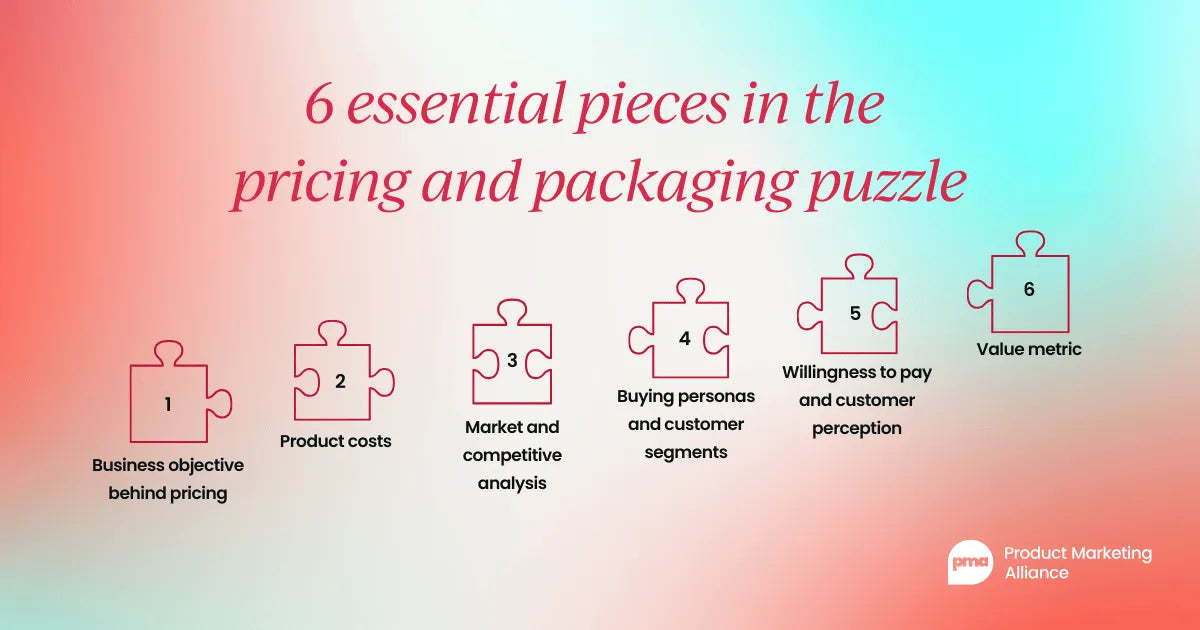
The Strategic Importance of Pricing: How Product Marketing Influences Pricing Decisions
Table of Contents
- Key Highlights:
- Introduction
- Who Owns Pricing?
- The Role of Product Marketing in Pricing Decisions
- How and Where PMM Can Add Value to the Pricing Process
- Real-World Examples of Pricing Strategies in Action
- Challenges in Pricing Strategy Development
- Best Practices for Effective Pricing Strategies
- FAQ
Key Highlights:
- Pricing is a complex, cross-functional challenge that requires collaboration across various departments, particularly product marketing.
- Effective pricing strategies are essential for sustaining long-term customer relationships and maximizing lifetime value (LTV).
- Product marketing professionals (PMMs) play a crucial role in bridging the gap between customer perception of value and pricing strategy, ensuring alignment with market dynamics.
Introduction
In the realm of business, pricing strategies stand as pivotal elements that influence a company's success or failure. Pricing is not merely a number; it reflects a company's understanding of its market, its product's value, and its customer base. For product marketing professionals, navigating the intricacies of pricing and packaging is a formidable task, especially within the varied contexts of B2B and B2C markets. The alignment of pricing strategies with market needs is essential, yet many organizations struggle with establishing a cohesive approach. This article delves into the multifaceted relationship between product marketing and pricing, exploring how PMMs can effectively contribute to pricing decisions that resonate with customers and drive revenue growth.
Who Owns Pricing?
The question of ownership in pricing often sparks debate within organizations. Traditionally, final pricing decisions reside with revenue operations, finance, or growth teams. However, confining pricing ownership to a single department can lead to significant pitfalls. When pricing is treated as an isolated function, it risks becoming disconnected from the product and failing to account for the customer's perspective. Organizations may fall into the trap of making decisions based solely on financial metrics such as margins and profits, adopting a short-term revenue mindset that neglects the long-term relationship with customers.
To foster a more holistic approach, pricing should be viewed as a collaborative effort involving multiple stakeholders, including finance, sales, product management, and, crucially, product marketing. PMMs serve as the critical link between the value delivered by the product and how customers perceive that value. Without their insight, companies may miss vital opportunities to align pricing strategies with customer expectations and market realities.
The Role of Product Marketing in Pricing Decisions
Product marketing professionals are uniquely positioned to influence pricing strategies. They are tasked with positioning the product, articulating its value proposition, and comprehensively understanding the market landscape. PMMs possess valuable market intelligence and insights into customer needs and pain points, which are essential for developing effective pricing models. Their deep understanding of customer perception directly impacts what customers are willing to pay.
Despite their crucial role, the relationship between product marketing and pricing can often be fraught with tension. PMMs frequently encounter situations where pricing decisions are made with inadequate market input, leading to misaligned strategies and ineffective pricing models. This disconnect can create frustration for PMMs who recognize their potential contributions but are not always afforded the opportunity to influence pricing decisions.
How and Where PMM Can Add Value to the Pricing Process
The art of pricing requires a delicate balance. Setting the price too high can alienate potential customers, while pricing too low can undervalue the product and erode margins. PMMs must master several key components to develop effective pricing strategies:
- Market Dynamics: Understanding the market landscape, including competitors and emerging trends, is essential. This knowledge enables PMMs to position their products effectively and adjust pricing in response to market changes.
- Financial Logic: Familiarity with the product's financial mechanics—such as acquisition costs and service costs—provides PMMs with a solid foundation for making informed pricing decisions. They must work closely with finance teams to interpret financial data and understand the implications of pricing choices.
- Customer Needs: A thorough grasp of customer needs and pain points allows PMMs to craft pricing models that resonate with the target audience. By understanding what drives customer decisions, PMMs can better align pricing with perceived value.
6 Essential Pieces in the Pricing and Packaging Puzzle
To create a comprehensive pricing strategy, PMMs should consider the following essential elements:
1. Business Objective Behind Pricing
Pricing strategies may arise from various business objectives, including launching a new product, responding to market shifts, expanding into new regions, or adapting to regulatory changes. It is vital to align pricing approaches with the company's overarching goals. For instance, a company aiming to drive revenue growth may adopt aggressive pricing, while one focused on increasing user adoption might prioritize competitive pricing structures.
2. Product Costs: Your Baseline
Understanding the financial underpinnings of the product is crucial for establishing a pricing baseline. This involves considering both acquisition costs (the cost of acquiring new users) and service costs (the cost of delivering the product). PMMs should work with finance teams to assess the lowest price that maintains healthy margins without compromising perceived value.
3. Market and Competitive Analysis
Conducting a thorough analysis of competitors is essential. PMMs should map key competitors, evaluate their pricing models, packaging strategies, and value-added services. This competitive landscape analysis helps PMMs identify opportunities for differentiation and informs pricing decisions that can enhance market positioning.
4. Buying Personas and Customer Segments
Understanding the diverse needs of different customer segments is critical for effective pricing. Each segment may exhibit varying levels of price sensitivity and willingness to pay. PMMs should utilize internal data, market analysis, and user research to define customer segments accurately and tailor pricing strategies accordingly.
5. Willingness to Pay and Customer Perception
Willingness to pay (WTP) is a pivotal factor in pricing strategy. PMMs must gauge customer perceptions of value and how these perceptions influence their purchasing decisions. Techniques such as value perception assessments and customer interviews can provide valuable insights into what customers deem acceptable pricing.
6. Value Metric
The final component to consider is the value metric—what aspect of the product customers value the most. This could be features, performance, or even customer support. Aligning pricing with the identified value metric ensures that customers feel they are receiving fair value for their investment.
Real-World Examples of Pricing Strategies in Action
Several companies exemplify successful integration of product marketing and pricing strategies.
Example 1: Adobe
Adobe's transition to a subscription-based pricing model for its Creative Cloud suite serves as a compelling case study. By understanding customer needs for flexibility and access to the latest features, Adobe shifted its pricing strategy to accommodate a broader audience. This move not only increased customer retention but also expanded its user base significantly.
Example 2: HubSpot
HubSpot's tiered pricing model is another illustration of effective pricing strategy. By segmenting its offerings into different tiers based on user needs and budget constraints, HubSpot successfully caters to a diverse clientele. The marketing team plays a crucial role in communicating the value of each tier, ensuring that customers understand what they receive at each price point.
Challenges in Pricing Strategy Development
Despite the clear importance of aligning product marketing with pricing strategy, several challenges persist:
- Siloed Departments: Often, departments operate in silos, leading to fragmented pricing decisions that do not reflect the collective insights of the organization.
- Lack of Market Research: Pricing decisions made without thorough market research can result in misaligned strategies that fail to resonate with customers.
- Dynamic Market Conditions: Rapid changes in market conditions can quickly render pricing strategies obsolete, necessitating continuous monitoring and adjustment.
Best Practices for Effective Pricing Strategies
To overcome these challenges, organizations should adopt the following best practices:
- Foster Collaboration: Encourage cross-functional collaboration between product marketing, finance, sales, and product teams to ensure a unified approach to pricing.
- Invest in Market Research: Prioritize ongoing market research to stay attuned to customer preferences and competitive dynamics.
- Utilize A/B Testing: Implement A/B testing to evaluate the effectiveness of different pricing models and make data-driven adjustments.
- Emphasize Customer Feedback: Regularly gather customer feedback to assess perceptions of value and willingness to pay.
FAQ
What factors should be considered when setting a price for a product? When setting a price for a product, factors such as market dynamics, product costs, competitive analysis, customer segments, and willingness to pay should all be considered.
How can product marketing professionals influence pricing decisions? Product marketing professionals can influence pricing decisions by providing valuable insights into market needs, customer perceptions, and competitive positioning, ensuring that pricing aligns with the perceived value of the product.
What are the consequences of having a single owner for pricing decisions? Having a single owner for pricing decisions can lead to a disconnect between pricing and product value, neglect of the user perspective, and an overemphasis on short-term financial metrics, potentially harming long-term customer relationships.
Why is it important to understand customer segments in pricing strategy? Understanding customer segments is crucial because different segments may exhibit varying levels of price sensitivity and willingness to pay. Tailoring pricing strategies to these segments can enhance customer satisfaction and drive sales.
How can companies adapt their pricing strategies to changing market conditions? Companies can adapt their pricing strategies to changing market conditions by conducting regular market research, leveraging customer feedback, and utilizing A/B testing to evaluate the effectiveness of different pricing models.
POWER your ecommerce with our weekly insights and updates!
Stay aligned on what's happening in the commerce world
Email Address
Handpicked for You

08 September 2025 / Blog
How to Avoid Greenwashing: Rules, Real-World Examples, and a Practical Playbook for Honest Environmental Claims
Read more
08 September 2025 / Blog
Klaviyo 2025: How its AI-Driven CRM Transforms Shopify Email Marketing and the Customer Experience
Read more
08 September 2025 / Blog


